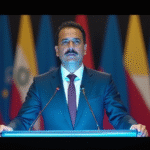Introduction
On September 19, 2025, Clara Brugada Molina, the Head of Government of Mexico City, presided over a civic ceremony commemorating the 40th anniversary of the September 19, 1985 earthquake and the eighth anniversary of the 2017 earthquake. The event highlighted the significance of solidarity and community organization in overcoming adversity.
Background on Clara Brugada Molina
Clara Brugada Molina is a prominent Mexican politician who has served as the Head of Government of Mexico City since 2018. With a background in law and public administration, she has been instrumental in implementing policies focused on social development, urban mobility, and disaster preparedness.
The 1985 Earthquake: A Turning Point for Mexico City
The 1985 earthquake, one of the deadliest in Mexico City’s history, claimed between 6,000 and 10,000 lives. Brugada Molina emphasized that the true tragedy was not the seismic activity itself but the vulnerability caused by corruption and negligence. She acknowledged that the citizens’ response during this disaster was crucial in saving lives and laying the groundwork for the city’s transformation.
- Estimated fatalities: 6,000 – 10,000
- 48,000 families left homeless
- 462 buildings collapsed
- Thousands of structures demolished
Post-1985 Transformations
Brugada Molina highlighted that the 1985 earthquake sparked significant grassroots transformations, emphasizing the importance of citizen participation in shaping the city’s future. She mentioned the creation of key institutions like the National System of Civil Protection (SNPC) and the National Center for Disaster Prevention (CENAPRED) in the following years.
Advances in Disaster Preparedness
Since the 1985 earthquake, Mexico City has made substantial progress in disaster preparedness. Brugada Molina praised the work of former Head of Government Claudia Sheinbaum, who played a vital role in strengthening the legal framework for transparency and rebuilding efforts following the 2017 earthquake.
- Creation of SNPC (1986)
- Establishment of CENAPRED (1988)
- Implementation of SASMEX (1991), an early warning seismic system
Today, Mexico City boasts one of the world’s most advanced earthquake monitoring systems, with strategically placed speakers and emergency response centers ready to address the city’s challenges.
Commitment to Vulnerable Populations
Brugada Molina reaffirmed her dedication to the safety of Mexico City’s residents by announcing a new program to reinforce vulnerable buildings against earthquakes. The city government has doubled its housing budget, allocating over 900 million pesos to various initiatives.
- 200,000 housing actions planned
- Creation of a tenants’ advocacy office
- “OTOCH” program for maintenance, major repairs, and rehabilitation of 1,200 housing units (600 million pesos investment)
The Head of Government emphasized the importance of ensuring the viability and safety of all buildings in Mexico City through this comprehensive reinforcement program.
Tribute to First Responders
The ceremony concluded with a heartfelt tribute to the first responders, including rescue workers, firefighters, protection and rescue personnel, ERUM, mobile prehospital care teams, police officers saving lives, and the organized society that supports citizens. Brugada Molina celebrated the resilience of Mexico City’s people, who have shown solidarity and strength in the face of adversity for four decades.
“Viva the capital of solidarity!”






